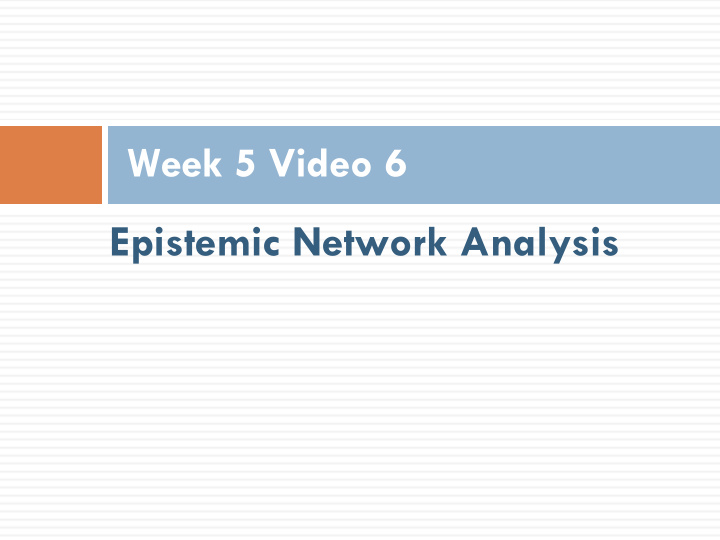



Week 5 Video 6 Epistemic Network Analysis
Today’s Class ¨ Epistemic Network Analysis
Epistemic Network Analysis (ENA) (Shaffer, 2017) ¨ Studying relationships between elements in coded data ¨ Lots of applications ¨ Conference founded around this method (in large part) ¤ International Conference on Quantitative Ethnography
Nodes and links ¨ Nodes = occurrences of the codes ¨ Links = co-occurrences of the codes
Let’s start with an example ¨ Chosen primarily because I understand it well
Analyzing Quitting Behavior (Karumbaiah et al., 2019) ¨ Comparing students who quit a level in the game Physics Playground to students who do not quit a game level ¨ In terms of the gameplay actions each group of students makes
Nodes and links ¨ Nodes are behaviors ¨ Links represent when a player demonstrates both behaviors in one session playing one level
Nodes and links ¨ When red students draw.freeform, they also erase ¨ Less commonly, when they draw.freeform, they also nudge ¨ When green students draw.freeform, they also ramp ¨ Less commonly, when they nudge, they also ramp
Comparing groups in data ¨ In this case, red= people who quit a game green = people who do not quit
Can Compare Graphs Between Contexts (here: game levels)
Interpreting the graphs in (Karumbaiah et al., 2019) ¨ Can seem tricky ¨ Very powerful when you dig into the graphs
Key Themes identified by Karumbaiah et al. (2019) ¨ Identifying Key Action ¨ Missing Identification of Supporting Objects ¨ Over-reliance on Nudge ¨ Limited Early Action Expansion and Later Action Convergence
Identifying Key Action Indicates their lack of conceptual understanding of Physics
Missing Identification of Supporting Objects
Over-reliance on Nudge Indicates potential wheel spinning tendencies
Limited Early Action Expansion and Later Action Convergence Need Fulcrum
Note ¨ We looked at these graphs qualitatively, but statistical analysis of differences is possible too ¤ Is link A stronger than link B? ¤ Is link Q stronger in group R or group S?
Other examples
Studying connections between topics in meetings over time (Nash & Shaffer, 2013)
Studying Process of Successful and Unsuccessful Teams (Arastoopour et al., 2016)
Exploring Shifts in Student Identity over Time (Barany & Foster, 2019)
Important setup questions ¨ What makes a relationship “stronger”?
Important setup questions ¨ What are your codes? ¨ How did you derive those codes? ¤ Behaviors in data ¤ Text mining ¤ Hand coding ¤ Hand coding THEN text mining (nCoder+) (Cai et al., 2019)
Important setup questions ¨ Which codes do you display? ¨ What are your aggregation units (stanzas)? ¤ Everything a learner does together ¤ Everything a learner does on a specific level together ¤ Everyone in a group of learners/team ¤ Everything in a piece of content ¤ Everything in a meeting
Referred to as Stanza-Based Interaction Data (Shaffer et al., 2016) A set of objects 1. The way they relate to each other 2. Grouped into a set of stanzas 3. That reveal evidence about the relationships 4. between the objects
Important setup questions ¨ One-directional relationships or bi-directional relationships? ¨ Usually bi-directional, but some work looks at one- directional relationships over time (Karumbaiah et al., in press)
Important setup questions ¨ What do the X and Y axes mean? ¤ Typically determined empirically by collapsing the feature space using SVD, singular value decomposition n Similar to factor analysis (week 7) ¤ This approach can make X and Y hard to interpret but best splits out the variables visually
ENA ¨ Important method, growing in scope and community applying it
Knowledge Graphs/Spaces ¨ Another key application of network analysis ¨ We will discuss this in week 7 as well
Next week ¨ Visualization
Recommend
More recommend